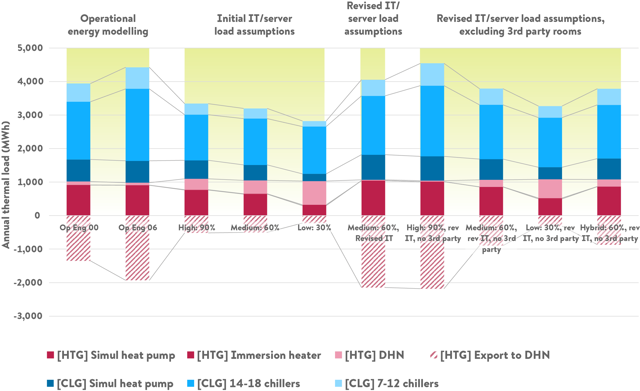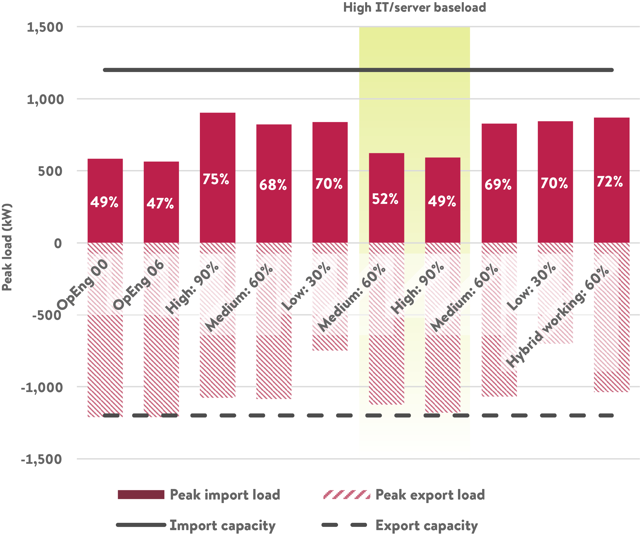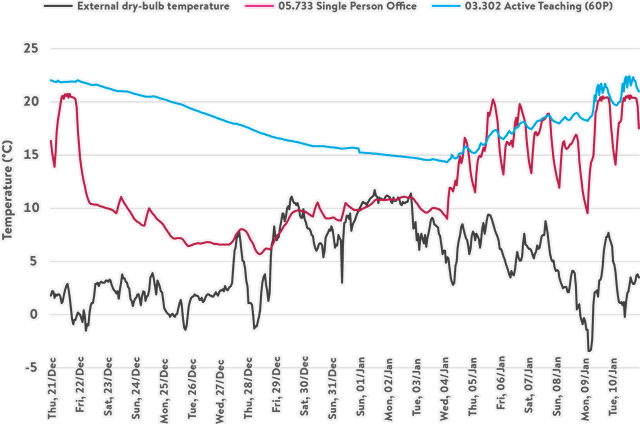Temple Quarter Enterprise Campus: Building performance modelling to assess impact of removing district heat network connection
Temple Quarter Enterprise Campus (TQEC) is a new landmark building for the University of Bristol (UoB). Currently under construction, this 38,000m2 building includes lecture theatres, IT teaching spaces, specialist laboratories, cellular offices and flexible working spaces for academics and students.

Step 2: Modelling a scenario where the district heating connection was removed to quantify underheating risk by calculating the resulting indoor temperature conditions during key periods.
Multiple occupancy and IT / server equipment scenarios were agreed with UoB to test how the systems perform under high- and low-gains scenarios. The dynamic operation of the building heating and cooling systems were analysed by adapting the existing TM54 operational energy model, in IES VE ApHVAC software.

Step 1 – Thermal Load Split
The annual thermal load provided by each generation source and the peak import and export load across the DHN plate heat exchanger (PHX) was calculated for each occupancy and IT / server load scenario combination.
From the results, it was noted that the dependence on heat from the DHN is driven more strongly by the IT / server load assumptions than occupancy. A tipping point was identified where there is a cooling baseload of ~200kW from continuous IT / server load. Below this load, the WWHP would not be able to operate as the demand is below the plant minimum turn-down, meaning any heat demand needs to be met by the DHN connection.

The maximum estimated peak import load of all scenarios was only two thirds of the design capacity of the PHX, meaning there is a good opportunity to reduce the connection capacity. Moreover, in scenarios where the base cooling load exceeds the identified ~200kW tipping point the maximum peak import load was only half of the design capacity, suggesting even greater savings could be made on connection capacity.
Conversely, the maximum peak load for export is consistently >1000kW for all scenarios other than the very lowest occupancy. However, the timing of this peak load may coincide with a period when the DHN will not accept rejected heat, e.g. during the summer months.

Step 2 – Thermal comfort
The operative temperature of all spaces was reported from the thermal model in Step 2, where the DHN connection is removed. The results showed that during the winter shutdown, when there is very little occupancy, the base cooling load is below the WWHP minimum turn-down. This means there is no on-site heating capacity so considerable underheating in spaces would occur on a frequent basis.

The extent of the underheating was found to be a significant risk in all scenarios, both during shut-down and occupied periods. For spaces with high façade losses internal temperatures could reach as low as 5°C, posing a risk to the fabric, furniture and equipment from condensation. During the first days of operation following the winter shutdown the building operative temperatures are likely to be consistently between 13-16°C. Using the thermal comfort criteria and clothing levels set out in CIBSE Guide A (2015), it was calculated that occupants would need to wear outdoor cold weather clothing (clo 2.5) to remain comfortable at these temperatures, which is impractical for working and does not conform to the Health and Safety Executive guidance for safe working conditions.

Conclusions
The study has demonstrated the importance of establishing off-axis and low-load scenarios based on the original design brief and considering these when defining the heating and cooling strategy and sizing of equipment. Following only the design brief can lead to unintended limitations to the flexibility of use for the building and underperformance of the building systems.
